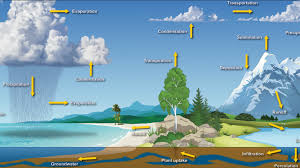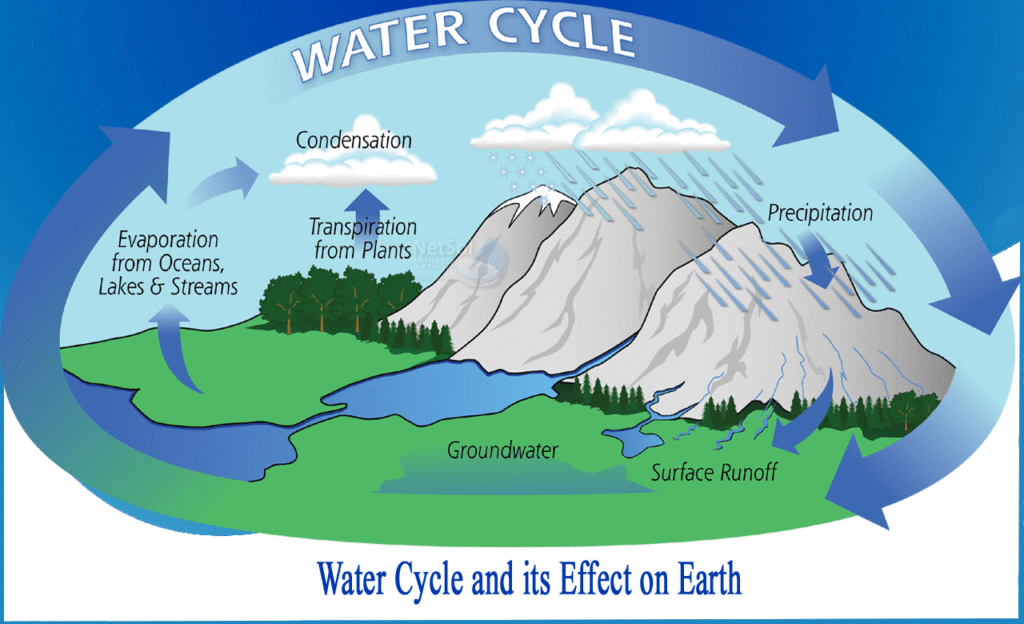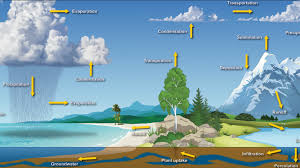Now Reading: This Natural Water Cycle Controls Life on Earth – Here’s How 2025
-
01
This Natural Water Cycle Controls Life on Earth – Here’s How 2025
This Natural Water Cycle Controls Life on Earth – Here’s How 2025

Water is one of the most important elements for life on Earth. From drinking water and food production to weather and energy, everything depends on a natural process called the hydrological cycle, also known as the water cycle. This cycle is Earth’s way of moving water through the air, land, and oceans, making it available for plants, animals, and people.
Although it happens every day around us, most people don’t realize how powerful and essential the water cycle really is. Without it, there would be no fresh water, no rain, and no way to grow food. In simple words, the hydrological cycle is Earth’s natural water engine that keeps life going.
Let’s explore what the hydrological cycle is, how it works, and why it is so important for people and the planet.
What Is the Hydrological Cycle?

The hydrological cycle is the continuous movement of water on, above, and below the surface of the Earth. It starts with evaporation, when the sun heats up water in rivers, lakes, and oceans, turning it into vapor. This vapor rises into the sky and cools down, forming clouds in a process called condensation.
Later, this water falls back to the ground as precipitation—in the form of rain, snow, or hail. Some of the water flows into rivers and lakes, some gets soaked by the soil, and some goes deep underground. Then, the process starts all over again.
There are five main stages in the hydrological cycle:
- Evaporation
- Condensation
- Precipitation
- Infiltration (water entering the ground)
- Runoff (water flowing over land back to rivers and oceans)
Each stage plays an important role in balancing the planet’s water supply.
Why Is the Hydrological Cycle Important?
The water cycle is more than just rain and evaporation. It touches every part of life. Here’s why it is so important:
1. Provides Fresh Water for Drinking
Most of the Earth’s water is salty and found in the oceans. Only about 3% is fresh water, and only a small part of that is easy to access. The water cycle helps bring fresh water to the surface, filling rivers, lakes, and underground sources. This makes it possible for humans, animals, and plants to survive.
2. Supports Agriculture and Food Production
Farmers depend on rain and soil moisture for growing crops. If the water cycle didn’t move water from the ocean to the land, farms would dry up. Rainfall from the hydrological cycle makes it possible to grow food in different parts of the world.
3. Maintains Weather and Climate Balance
The water cycle affects weather patterns. For example, the formation of clouds and rain helps cool down hot areas. Water vapor in the air can also trap heat, helping keep the planet warm enough to live. Any change in the water cycle can cause floods, droughts, or climate shifts.
4. Powers Renewable Energy Sources
Hydropower, one of the world’s main sources of clean energy, depends directly on the water cycle. Water from rain and snow feeds rivers, which are then used to turn turbines and produce electricity. Without a working water cycle, hydropower would not exist.
5. Cleans and Recycles Water
The natural movement of water through evaporation and condensation helps clean it. When water evaporates, it leaves behind salts and dirt, rising into the air as pure vapor. This vapor then falls as clean rain, helping to refill water sources.
6. Keeps Ecosystems Alive
Forests, wetlands, lakes, and oceans all depend on regular rainfall and water flow. If the water cycle is disrupted, entire ecosystems can die out. This affects wildlife, plant life, and even the air we breathe.
What Happens When the Water Cycle Is Disrupted?

While the hydrological cycle is natural, human activity can affect it in harmful ways. For example:
- Deforestation reduces rainfall in areas because trees play a role in releasing moisture into the air.
- Pollution from factories and cities can poison the water that flows back into rivers and lakes.
- Climate change caused by greenhouse gases is speeding up evaporation and changing rainfall patterns, leading to extreme weather like floods and droughts.
When the cycle is out of balance, it leads to serious problems—too much rain in one place and none in another, water shortages, crop failure, and loss of biodiversity.
How Can We Protect the Water Cycle?
There are simple actions that people, communities, and governments can take to keep the water cycle healthy:
- Plant more trees to improve air moisture and prevent soil erosion.
- Conserve water at home and in industries to reduce unnecessary usage.
- Reduce pollution by using less plastic and chemicals that can harm rivers and lakes.
- Protect wetlands and forests, which act as natural water filters and storage systems.
- Support climate-friendly policies to help control global warming, which is impacting the water cycle.
The Future of the Hydrological Cycle

With rising populations and increasing pollution, the pressure on Earth’s water systems is growing. Scientists and environmental experts are now studying the hydrological cycle closely to find better ways to manage water resources.
New technologies like rainwater harvesting, water recycling, and green infrastructure (like urban forests and green roofs) are being used in cities to support a healthy water cycle. Education and awareness about water use are also helping people make smarter choices.
Final Thoughts
The hydrological cycle is one of the most powerful and important natural systems on Earth. It keeps the planet green, growing, and full of life. Without it, there would be no drinking water, no rain, and no food.
Understanding and protecting the water cycle is not just the job of scientists or governments—it is something every person should care about. From saving water to planting trees, every small step helps keep this beautiful cycle alive for future generations.
Read More:- Deyaar’s Latest Announcement Shakes Up the UAE Property Market






















